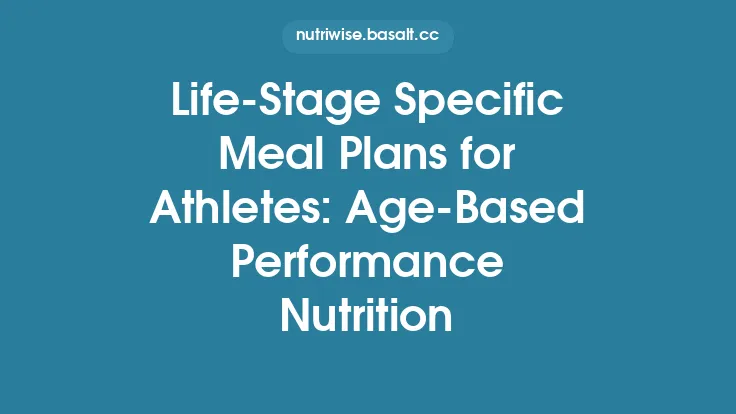College life brings a unique blend of excitement, academic pressure, and newfound independence. One of the first real tests of that independence is figuring out how to eat well without breaking the bank or sacrificing precious study time. While campus dining halls offer convenience, many students discover that a mix of home‑cooked meals, smart grocery shopping, and strategic meal planning can dramatically improve energy levels, focus, and overall well‑being. Below is a comprehensive guide that walks you through the essential components of a practical, student‑friendly meal plan—covering nutrition basics, budgeting tricks, pantry must‑haves, and flexible recipes that fit into a hectic schedule.
Understanding the College Student’s Nutritional Needs
College students often experience irregular schedules, late‑night study sessions, and fluctuating activity levels. Despite these challenges, the body still requires a balanced intake of macronutrients (carbohydrates, proteins, fats) and micronutrients (vitamins, minerals) to support:
- Cognitive performance – Glucose from complex carbs fuels the brain, while omega‑3 fatty acids support memory and concentration.
- Immune function – Adequate vitamins C, D, zinc, and selenium help fend off the common colds that thrive in dormitory environments.
- Muscle repair and growth – Protein (≈0.8–1.0 g per kg body weight) is essential, especially for students who engage in regular resistance training or sports.
- Hormonal balance – Healthy fats (avocado, nuts, olive oil) aid in hormone production, which can affect mood and stress response.
A practical rule of thumb is to aim for a plate that’s roughly ½ vegetables and fruits, ¼ lean protein, and ¼ whole‑grain carbohydrates, complemented by a modest portion of healthy fats. This “plate method” is easy to visualize and adaptable to any cuisine.
Budget‑Friendly Grocery Shopping Strategies
Money is often the biggest constraint for students. The following tactics can stretch a modest food budget (≈$30–$50 per week) without compromising nutrition:
| Strategy | How It Works |
|---|---|
| Shop the sales cycle | Most grocery stores rotate weekly specials. Plan meals around discounted items (e.g., a sale on chicken breasts or frozen berries). |
| Buy in bulk, portion out | Large bags of rice, beans, oats, and frozen vegetables are cheaper per serving. Portion them into zip‑top bags for easy storage. |
| Choose store brands | Generic versions of staples (canned tomatoes, broth, pasta) are nutritionally identical to name brands at a lower price. |
| Utilize student discounts | Many campus stores and local markets offer a student ID discount; don’t forget to ask. |
| Embrace frozen produce | Frozen fruits and veggies retain most nutrients and are often less expensive than fresh, especially out‑of‑season. |
| Plan a “no‑meat” day | Legumes, lentils, and tofu provide protein at a fraction of the cost of meat. |
Create a master shopping list that categorizes items into “always keep stocked,” “weekly essentials,” and “optional treats.” Stick to the list to avoid impulse buys.
Essential Kitchen Tools and Pantry Staples
Even a modest dorm kitchenette can become a culinary hub with a few versatile tools and pantry basics:
Tools
- 1‑quart saucepan with lid
- Non‑stick skillet or cast‑iron pan
- Small rice cooker or electric pressure cooker (e.g., Instant Pot) – excellent for batch cooking
- Cutting board and chef’s knife
- Measuring cups and spoons
- Reusable storage containers (glass or BPA‑free plastic)
Pantry Staples (store in airtight containers to extend shelf life)
- Whole grains: brown rice, quinoa, whole‑wheat pasta, oats
- Legumes: canned black beans, chickpeas, lentils (dry or canned)
- Proteins: canned tuna/salmon, eggs, tofu, tempeh, nut butter
- Flavor boosters: low‑sodium soy sauce, hot sauce, olive oil, vinegar, dried herbs, spices (garlic powder, cumin, paprika)
- Snacks: nuts, seeds, popcorn kernels, dried fruit
Having these items on hand means you can assemble a nutritious meal in 10–15 minutes, even on the busiest days.
Designing a Flexible Weekly Meal Plan
A successful meal plan balances structure with flexibility. Follow these steps to build a weekly template:
- Identify anchor meals – Choose 2–3 meals you’ll prepare the same way each week (e.g., “Monday & Thursday stir‑fry” or “Saturday batch‑cooked chili”).
- Allocate prep time – Reserve 1–2 hours on a low‑stress day (often Sunday) for batch cooking grains, proteins, and sauces.
- Map out leftovers – Plan for leftovers to serve as lunch or a quick dinner, reducing cooking frequency.
- Insert “quick‑fire” meals – Keep a list of 5‑minute options (e.g., Greek yogurt with fruit, avocado toast, microwaveable quinoa bowl) for days when time is scarce.
- Add variety – Rotate vegetables, proteins, and seasonings weekly to prevent palate fatigue.
Sample Weekly Layout (illustrative)
| Day | Breakfast | Lunch | Dinner | Snack |
|---|---|---|---|---|
| Mon | Overnight oats + berries | Quinoa‑black bean bowl (prep Sunday) | Chicken & veggie stir‑fry (batch) | Apple + peanut butter |
| Tue | Greek yogurt + granola | Leftover stir‑fry | Tuna‑avocado wrap | Carrot sticks + hummus |
| Wed | Scrambled eggs + spinach | Chickpea salad sandwich | Lentil soup (batch) + side salad | Trail mix |
| Thu | Smoothie (frozen fruit, spinach, protein powder) | Leftover lentil soup | Pasta primavera (quick) | Cottage cheese + pineapple |
| Fri | Whole‑grain toast + almond butter | Leftover pasta | DIY pizza on whole‑wheat pita (quick) | Dark chocolate square |
| Sat | Pancakes (whole‑grain) + banana | Picnic: turkey roll‑ups, fruit | Chili (batch) + cornbread | Popcorn |
| Sun | Veggie omelet | Leftover chili | Roast veggies + quinoa (fresh) | Yogurt parfait |
Feel free to swap days or ingredients based on personal preferences and schedule changes.
Quick and Nutritious Breakfast Options
Skipping breakfast is common when classes start early, but a balanced morning meal can improve alertness and curb mid‑morning cravings. Aim for a combination of complex carbs, protein, and healthy fats:
- Overnight oats – Mix rolled oats, milk (or plant‑based alternative), chia seeds, and a drizzle of honey; refrigerate overnight. Top with fresh or frozen fruit in the morning.
- Greek yogurt parfait – Layer Greek yogurt, granola, and mixed berries; add a spoonful of nut butter for extra calories.
- Egg‑based wraps – Scramble two eggs with spinach and cheese, wrap in a whole‑grain tortilla, and add salsa.
- Smoothie bowls – Blend frozen banana, frozen berries, spinach, protein powder, and almond milk; pour into a bowl and sprinkle with nuts and seeds.
- Whole‑grain toast – Top with avocado, a sprinkle of red pepper flakes, and a poached egg for a dose of healthy fats and protein.
All of these can be prepared in under 10 minutes, and many can be pre‑made the night before.
Lunch Solutions for On‑Campus and Off‑Campus
Lunch is often eaten between back‑to‑back classes, so portability and speed are key. Here are three categories of lunch ideas:
- Grab‑and‑go bowls – Assemble a base of cooked grains, add a protein (canned tuna, grilled chicken, tofu), toss in raw or roasted veggies, and finish with a simple dressing (olive oil + lemon). Store in a reusable container for easy transport.
- Wraps and sandwiches – Use whole‑grain tortillas or bread, layer with lean protein, leafy greens, and a spread (hummus, mustard). Wrap tightly in foil or parchment to keep fresh.
- Soup and salad combos – Heat a pre‑made soup (lentil, minestrone, chicken noodle) in a microwave and pair with a side salad topped with nuts or seeds for crunch.
Pro tip: Keep a small cooler bag in your backpack for perishable items like cheese, yogurt, or cut fruit. Ice packs can extend freshness for a full day.
Dinner Ideas That Balance Time, Cost, and Health
Dinner is the opportunity to refuel after a long day, but it doesn’t have to be a marathon cooking session. Below are three dinner frameworks that can be adapted to any taste:
- One‑pot meals – Combine protein, vegetables, and a grain in a single pot or skillet. Examples: chicken and brown rice casserole, shrimp and quinoa skillet, or vegetarian chili with beans and sweet potatoes.
- Sheet‑pan roasts – Toss chopped veggies and a protein (salmon, tofu, chicken thighs) with olive oil and seasonings, spread on a baking sheet, and roast at 400 °F for 20–30 minutes. Minimal cleanup required.
- Stir‑fry & noodles – Quickly sauté a mix of frozen or fresh veggies with thinly sliced meat or tofu, add a splash of low‑sodium soy sauce, and serve over pre‑cooked rice or whole‑wheat noodles.
Each of these can be prepared in 30 minutes or less, especially if you pre‑cook the grain component earlier in the week.
Smart Snacking and Hydration
Snacks should complement meals, not replace them. Aim for a combination of protein, fiber, and a small amount of healthy fat to sustain energy between classes:
- Nut‑butter packets + apple slices – Portable and satisfying.
- Greek yogurt + honey – Provides calcium and probiotics.
- Roasted chickpeas – Crunchy, high‑protein, and easy to season.
- Veggie sticks + hummus – Low‑calorie, high‑fiber option.
Hydration is often overlooked. Keep a reusable water bottle on your desk and aim for at least 2 L of water daily. Adding a slice of lemon or cucumber can make it more appealing.
Accommodating Dietary Restrictions and Preferences
College campuses are increasingly diverse, and many students follow specific dietary patterns (vegetarian, vegan, gluten‑free, halal, kosher, etc.). Here’s how to stay flexible:
- Build meals around a “core” protein – Legumes, tofu, tempeh, eggs, dairy, or lean meats can be swapped without altering the rest of the recipe.
- Use gluten‑free grains – Quinoa, rice, and certified gluten‑free oats replace wheat‑based options.
- Seasonings over sauces – Flavor dishes with herbs, spices, citrus, and vinegars rather than relying on pre‑made sauces that may contain hidden allergens.
- Label your containers – If you share a mini‑fridge, clearly label items to avoid cross‑contamination.
When dining hall options are limited, bring a “backup” snack that meets your dietary needs to avoid compromising nutrition.
Meal Prep Techniques for Busy Weeks
Effective meal prep reduces daily decision fatigue and ensures you always have a nutritious option at hand. Follow these streamlined steps:
- Batch‑cook staples – Cook a large pot of quinoa, a tray of roasted vegetables, and a batch of protein (e.g., baked chicken breast) on Sunday. Store in portion‑sized containers.
- Portion out sauces – Prepare a few versatile sauces (e.g., tahini‑lemon, salsa, pesto) in small jars; they can instantly transform a plain bowl.
- Use the “mix‑and‑match” method – Combine any protein with any grain and any vegetable for endless variations.
- Freeze for later – Soups, stews, and cooked beans freeze well. Label with date and reheat in the microwave or stovetop.
- Keep a “prep‑day” checklist – Write down what you’ll cook, what containers you’ll need, and a timeline to stay organized.
Even dedicating just 90 minutes to prep can supply you with 5–7 days of ready‑to‑eat meals.
Navigating Dining Halls and Campus Food Services
Dining halls can be a convenient source of nutrition, but they also present challenges like limited healthy choices or over‑reliance on processed foods. Here’s how to make the most of them:
- Follow the “plate method” – Fill half the tray with vegetables and fruits, a quarter with lean protein (grilled chicken, fish, beans), and the remaining quarter with whole grains (brown rice, whole‑wheat pasta).
- Prioritize the salad bar – Load up on leafy greens, colorful veggies, nuts, and a lean protein topping. Use vinaigrette sparingly.
- Watch portion sizes – Buffet lines encourage “all‑you‑can‑eat” mentality; serve yourself modestly, then go back for seconds if still hungry.
- Utilize nutrition information – Many campuses post calorie counts and ingredient lists; use them to make informed choices.
- Bring your own side – If the main line lacks a healthy option, supplement with a pre‑packed snack (e.g., a container of edamame or a piece of fruit).
By treating the dining hall as one component of your overall plan, you can enjoy the convenience without compromising your goals.
Sustainability and Reducing Food Waste
College students often generate food waste due to over‑purchasing or forgetting leftovers. Sustainable habits not only save money but also benefit the environment:
- Shop with a list – Stick to what you need; avoid impulse buys that may go unused.
- Practice “first‑in, first‑out” – Organize your fridge and pantry so older items are used before newer ones.
- Portion mindfully – Serve yourself only what you intend to eat; keep extra portions for later meals.
- Repurpose leftovers – Turn roasted veggies into a frittata, use stale bread for croutons, or blend leftover fruit into smoothies.
- Compost if possible – Many campuses have compost bins for food scraps; take advantage of them.
These small adjustments can significantly cut down on waste while extending your food budget.
Monitoring Progress and Adjusting Your Plan
A meal plan is a living document. Regularly assess how well it’s meeting your needs:
- Track energy and mood – Note any patterns of fatigue, brain fog, or mood swings that may correlate with meals.
- Weigh and measure – If weight management is a goal, check weekly trends rather than daily fluctuations.
- Adjust macronutrient ratios – If you feel sluggish, consider increasing complex carbs; if you’re sore after workouts, boost protein intake.
- Solicit feedback – Talk with a campus nutrition counselor or use reputable apps (MyFitnessPal, Cronometer) for data‑driven insights.
Make incremental tweaks rather than overhauling the entire plan at once; this promotes sustainable habits.
Resources and Tools for Ongoing Success
- Campus nutrition services – Many universities offer free consultations, cooking workshops, and nutrition handouts.
- Meal‑planning apps – “Mealime,” “Paprika,” and “Yummly” allow you to store recipes, generate grocery lists, and schedule meals.
- Online recipe databases – Websites like “Budget Bytes” and “Supercook” specialize in low‑cost, ingredient‑driven recipes.
- Student discount grocery programs – Look for local co‑ops or bulk stores that provide student pricing.
- Community groups – Join campus cooking clubs or online forums (Reddit’s r/collegecooking) for recipe swaps and motivation.
Leveraging these resources can keep your meal planning fresh, affordable, and aligned with your academic and personal goals.
By understanding the unique nutritional demands of college life, mastering budget‑savvy shopping, and building a flexible yet structured meal plan, students can fuel their bodies and minds without sacrificing time, money, or flavor. The strategies outlined above are evergreen—applicable year after year, regardless of major, campus, or personal taste—empowering you to take control of your campus cuisine and thrive academically and personally. Happy cooking!





